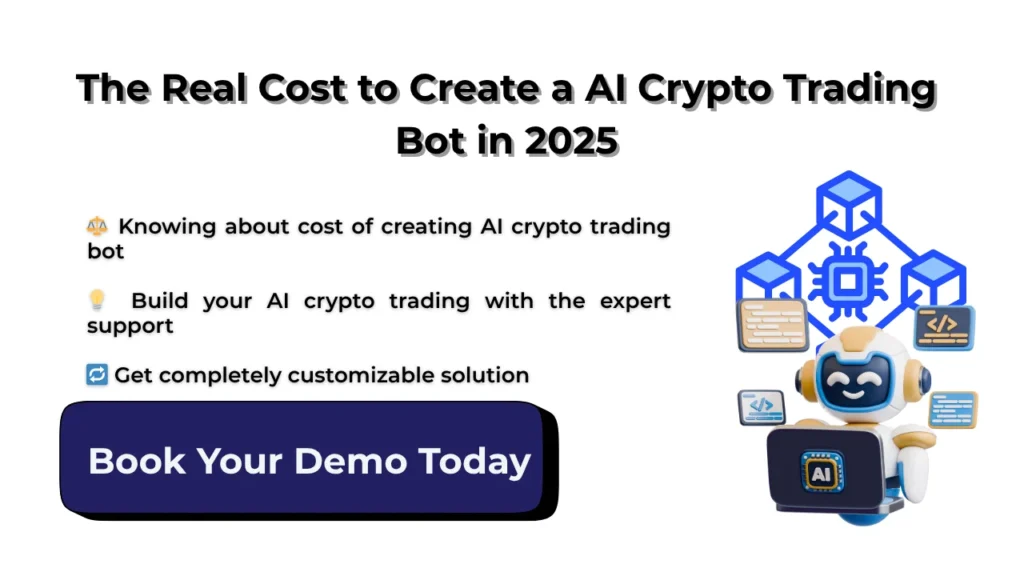Traditional crypto trading bots follow predetermined rules and algorithmic strategies programmed by developers. They execute when specific conditions are met—price crosses moving average, RSI reaches oversold levels, or volume exceeds thresholds—but lack adaptive intelligence to evolve with changing market conditions.
AI-powered crypto bot creation leverages machine learning, neural networks, and advanced analytics to create systems that learn from historical data, adapt to evolving market patterns, identify complex correlations humans miss, predict future price movements, and continuously optimize strategies based on performance outcomes.
These intelligent systems process vast datasets including price history, trading volumes, order book depth, social media sentiment, news headlines, blockchain metrics, and macroeconomic indicators—synthesizing information into actionable trading decisions that traditional bots cannot replicate.
Professional traders and institutions increasingly rely on AI bots to maintain competitive edges in markets where milliseconds determine profitability and human psychology creates costly mistakes.
The cost to create a AI crypto trading bot varies dramatically based on complexity, features, and customization requirements. Understanding different tiers helps determine appropriate budgets.
Development Timeline: 1-3 months
Ideal For: Individual traders testing automation, startups validating concepts, educational projects learning AI trading fundamentals, and hobbyists exploring algorithmic trading.
Limitations: Basic bots lack sophisticated pattern recognition, cannot adapt to rapidly changing markets, offer limited customization options, and may underperform during volatile conditions requiring nuanced decision-making.
Development Timeline: 3-6 months
Ideal For: Professional traders managing significant capital, trading firms seeking competitive advantages, fintech startups building commercial products, and investment funds requiring automation.
Advantages: Intermediate bots offer substantially improved prediction accuracy, better risk-adjusted returns, greater flexibility and customization, and ability to implement complex multi-asset strategies.
High-end AI-powered crypto bot creation commanding investments from $100,000 to $500,000 or more deliver cutting-edge capabilities for institutional requirements.
Understanding specific cost drivers within the overall cost to create a AI crypto trading bot helps budget accurately and prioritize features.
AI/ML Engineer Salaries: Experienced machine learning engineers command $100-$200+ per hour depending on expertise and location. A typical project requires 500-2,000+ hours depending on complexity, translating to $50,000-$400,000+ in engineering costs alone.
Backend Development: Building robust infrastructure for data processing, order execution, and system management requires experienced backend developers at $75-$150 per hour for 300-1,000 hours ($22,500-$150,000).
Frontend Development: User interfaces for monitoring, configuration, and analysis require frontend specialists at $60-$120 per hour for 200-600 hours ($12,000-$72,000).
DevOps Engineering: Infrastructure setup, deployment automation, and monitoring systems need DevOps expertise at $80-$150 per hour for 100-400 hours ($8,000-$60,000).
Quality Assurance: Comprehensive testing ensuring reliability requires QA specialists at $50-$100 per hour for 200-500 hours ($10,000-$50,000).
Project Management: Coordinating development, managing timelines, and ensuring quality requires project management at $75-$150 per hour for 100-300 hours ($7,500-$45,000).
Cloud Hosting: High-performance computing for AI model training and real-time trading requires robust cloud infrastructure. Monthly cost to create an AI crypto trading bot range from $500-$5,000+ depending on computational requirements, data storage, and traffic volumes.
Exchange API Fees: While most exchanges offer free API access, some charge for premium features, higher rate limits, or websocket connections. Budget $0-$500 monthly per exchange.
Data Sources: Historical price data, order book data, alternative data (sentiment, on-chain metrics) from premium providers costs $100-$5,000+ monthly depending on scope and granularity.
Security Infrastructure: SSL certificates, DDoS protection, intrusion detection, and security monitoring services cost to create an AI crypto trading bot $100-$2,000+ monthly for comprehensive protection.
Development Tools: Software licenses for development environments, testing tools, analytics platforms, and collaboration software add $500-$2,000+ monthly during active development.
Data Collection and Preparation: Gathering, cleaning, and formatting training data requires significant effort. Budget $5,000-$50,000 depending on data volume, quality requirements, and preprocessing complexity.
Model Training: Training sophisticated AI models requires computational resources. GPU/TPU cloud computing for model training costs $1,000-$20,000+ depending on model complexity, training duration, and experimentation iterations.
Model Optimization: Hyperparameter tuning, architecture optimization, and performance enhancement require iterative processes costing $5,000-$30,000 in additional engineering time and computing resources.
Validation and Testing: Rigorous model validation through cross-validation, backtesting, and paper trading requires $3,000-$20,000 in engineering time and infrastructure.
Exchange Integration: Connecting to cryptocurrency exchanges via APIs requires development effort varying by exchange complexity. Budget $2,000-$10,000 per exchange for robust, production-ready integration.
Wallet Integration: Secure wallet connectivity for managing cryptocurrency assets costs $3,000-$15,000 depending on security requirements and supported cryptocurrencies.
Payment Gateway Integration: If offering commercial services, payment processing integration costs $2,000-$10,000 depending on complexity and compliance requirements.
Third-Party Services: Integrating notification services, monitoring tools, analytics platforms, and other services costs $1,000-$5,000 per integration.
Security Audit: Professional security audits identifying vulnerabilities cost $10,000-$50,000+ depending on system complexity and audit depth.
Penetration Testing: Ethical hacking to validate security measures costs $5,000-$25,000 for comprehensive testing.
Compliance Consulting: Legal and regulatory compliance expertise for operating trading systems costs $5,000-$50,000+ depending on jurisdictions and regulatory requirements.
Insurance: Cybersecurity insurance protecting against breaches and losses costs $2,000-$20,000+ annually depending on coverage limits and risk profiles.
Server Hosting: Production infrastructure handling live trading requires $1,000-$10,000+ monthly depending on scale, redundancy requirements, and geographic distribution.
Database Services: Storing historical data, trade logs, and user information costs $200-$2,000+ monthly for managed database services.
Monitoring and Alerting: System health monitoring, performance tracking, and incident alerting services cost to create an AI crypto trading bot is $100-$1,000 monthly.
Backup and Disaster Recovery: Automated backups and disaster recovery infrastructure costs $200-$2,000 monthly ensuring business continuity.
Bug Fixes and Updates: Ongoing development addressing bugs, security patches, and minor improvements requires 20-100+ hours monthly at $100-$200 per hour ($2,000-$20,000+ monthly).
Model Retraining: AI models degrade over time as market conditions evolve. Regular retraining requires $1,000-$10,000+ monthly in computing resources and engineering time.
Feature Enhancements: Adding new capabilities, integrations, and optimizations requires ongoing development investment of $5,000-$50,000+ monthly for active projects.
Technical Support: Providing user support, troubleshooting issues, and answering questions requires $2,000-$20,000+ monthly depending on user base and support quality expectations.
Real-Time Data Feeds: Premium real-time price, order book, and trade data costs $500-$5,000+ monthly from exchanges or data providers.
Alternative Data: Sentiment analysis, on-chain metrics, social media data, and other alternative data sources cost $500-$10,000+ monthly.
News Services: Financial news APIs providing real-time updates cost $200-$2,000+ monthly.
Research Tools: Access to research platforms, backtesting tools, and analytics services costs $300-$3,000+ monthly.
Several variables significantly impact the total cost to build AI crypto bot solutions, helping you understand pricing variations and make informed decisions.
Simple strategies based on technical indicators cost less to implement than sophisticated multi-factor models incorporating fundamental analysis, sentiment data, and predictive analytics. Complex strategies requiring advanced AI models, extensive historical data, and sophisticated risk management increase development costs by 2-5x compared to basic approaches.
Each exchange integration requires custom development for API connectivity, order management, and data handling. Supporting 1-2 exchanges is straightforward, while integrating 10+ exchanges substantially increases complexity and costs.
Basic machine learning models (linear regression, decision trees) are relatively simple to implement. Advanced deep learning architectures (LSTM networks, transformers, reinforcement learning) require specialized expertise, extensive computing resources, and significantly longer development timelines, increasing costs by 3-10x.
Bots executing trades every few minutes have modest latency requirements. High-frequency trading requiring microsecond execution demands sophisticated infrastructure, low-latency networking, and optimized code, increasing costs substantially.
Basic security is relatively inexpensive. Institutional-grade security with multi-factor authentication, hardware security modules, penetration testing, and comprehensive auditing increases costs by $50,000-$200,000+.
Bots handling modest trading volumes on standard infrastructure cost less than systems requiring horizontal scaling, load balancing, and distributed architecture supporting high-frequency institutional trading.
Operating in unregulated environments requires minimal compliance investment. Systems targeting regulated markets need legal consultation, compliance frameworks, reporting capabilities, and ongoing monitoring, adding $25,000-$200,000+ to costs.
Simple command-line interfaces or basic dashboards cost $10,000-$30,000. Sophisticated web applications with real-time visualizations, mobile apps, and comprehensive analytics increase costs by $50,000-$150,000+.
Comprehensive backtesting requires historical data acquisition ($5,000-$25,000), computing resources for simulations ($2,000-$20,000), and engineering time analyzing results ($5,000-$30,000). Paper trading validation adds monitoring infrastructure and opportunity costs during testing periods.
AI development involves experimentation. Many approaches fail before finding successful models. Budget 30-50% additional costs for failed experiments and pivot iterations.
Rushing development creates technical debt requiring later refactoring. Budget 20-30% of initial development costs for addressing technical debt as projects mature.
Comprehensive documentation enabling maintenance and knowledge transfer requires 10-15% of total development time but is often neglected, creating future costs.
Internal team training on system operation, strategy adjustment, and troubleshooting requires time investment often underestimated during budgeting.
Exchange API rate limits may require premium accounts or multiple accounts for high-frequency bots, adding unexpected recurring costs.
Large trades impact market prices. Sophisticated order execution algorithms minimizing market impact require additional development investment.





